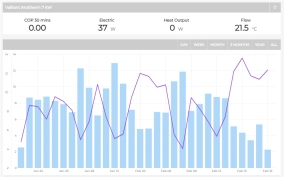Our new Air Source Heap Pump has now been installed and running for a month. I thought some people might be interested in how we’re getting on.
For context: Our home is a 114m² timber framed 3 bed bungalow, 50 years old. EPC B. We have 20 year old double glazing and around 10″ of 20 yr old rockwool in the loft, and 100mm PIR insulation under the suspended floor. Reasonable draft proofing, but by no means air tight. We have 4kWp solar panels on the roof from 13 years ago, and 8.2kWp battery from 3 years ago.
The heat loss calculation, very carefully done by Chris & Alex of HeatAC, was 6.1 kW at -4°C and the system was designed to meet that with a 45° “flow temperature” (roughly the radiator temperature). We went for a 7kW Vaillant Aerotherm. (See earlier article for more details)
Well, it was great when it first went in, and it’s still great! The house and air are cleaner, and we are comfortably warm all the time with a whole lot less effort. I’ll sum up our numbers, and you can see what you think.
I’ll admit it, we were nervous about how this would pan out, before we started. One hears dreadful stories of appalling installations. Our primary concern was: we’ve always been a very low usage house, low on gas consumption and on electricity. (Some would say, “tight”!) One or two hours of gas in the morning, log burner with free logs (historically) in the afternoon/evening. Recently we’ve had to buy logs, which are roughly equivalent to the gas price. We had already switched to an induction hob and to heating water electrically during the overnight cheap rate, a couple years ago.
We used 2,708kWh electricity in 2023 (though we only bought 1/3rd of that, and nearly all at the cheap rate because of the battery) and 2,441kWh gas. How much more would we end up paying to run a heat pump?
Our interim hypothesis, one month in, is that you can be as warm or cool as you choose. As previously stated, the right design and a good installation are the key factors. Higher usage homes will likely use more for the heat pump also. Batteries and solar panels really sweeten the mix, but are not mandatory. A time-of-use tariff can be advantageous. Whatever the design temperature, it will seldom have to operate at that level.
We run the house at 19°C most of the time, and 20.5°C during the evening. Some observations from our experience so far:
- The first day was very cold outside (Lo -7°, Hi 2°), the control was via room stat, and it used 26.6 kWh (COP* 3.8). After changing to “weather compensation”* modified by room temp (Vaillant calls it “enhanced mode”), the next day (also cold externally, Lo -3°, Hi 5°) was 18.1kWh (COP 4.7). The averages include that first very high day.
- We heat water during the night rate, for around an hour, and it uses 1-1.5kWh typically. (It was normally about 5kWh by immersion heater, previously.)
- During colder days, the radiators were around 30°-35°C. In this slightly warmer spell the radiator temperature is in the 20s. When it was below zero outside, the radiator temperature was still below 40°C.
- The average WINTER daily electricity consumption by the HP is around 9kWh per day. On our tariff, using a battery (and solar when available), that costs an average of 82p per day. Average COP for the past month is 5.9 including hot water.
- Average gas use for this period, over 2021-22, was £35, plus £65 for 1m³ logs. We’ve spent £25 on electricity for the heat pump, so far this year.
- A couple days ago it reached 15°C and sunny, and the heating took only 3.5kWh (COP 6.1). That will be more representative of spring and autumn.
- There were 5 days in January and 12 days in February (in this period) when we could run off battery the whole day, and so didn’t use any full price electricity.
- The heat pump on average uses around 53% of our electricity. Which means we’ve replaced all the kWh of gas with slightly more electricity, but are getting 5-6x the benefit in warmth.
- To put it another way, it has roughly doubled our electricity usage, but our gas is now Zero and no standing charge. (We’ve heard this ratio from others also, but I don’t know if it’s generally true.)
I’ll probably edit this further for clarity, over time – it’s hard to express things understandably, when there are so many numbers!
(Visit these other pages if you’re wondering how we found our installer, or our experience of the installation.) (Figure 1 at the top is from a site our son wrote for his heat pump, and it uses our numbers but doesn’t access our COP. The blue bars are energy used, the purple line is average external temperature. The live site is interactive down to some detail.)
* COP: “coefficient of performance” – for every 1kWh the heat pump uses, we get on average 5.9kWh of heat from it.
* weather compensation: (When the weather gets colder, the flow temperature is increased slightly by the automatic controls. When it’s warmer, the flow temperature is decreased, and hence the temperature of the rads is altered. The result is, the temperature of the room stays the same.)
References
- Energy Saving Trust info about heat pumps
- Which? magazine information about heat pumps
- Heat Geek website and YouTube channel
- Heat Punk software
